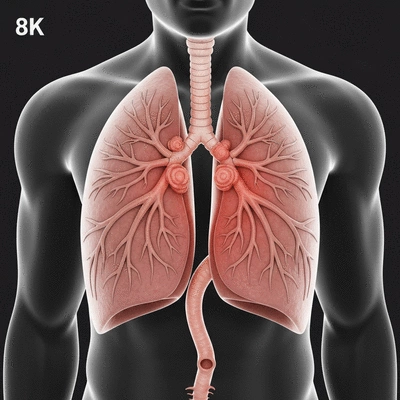Acid Reflux and Respiratory Problems

What if your persistent cough or wheezing could be linked to something as common as heartburn? Understanding the connection between gastroesophageal reflux disease (GERD) and respiratory issues is key to reclaiming your health.
What You Will Learn
- GERD can lead to chronic respiratory symptoms, including cough and wheezing.
- Microaspiration of stomach acid may cause airway inflammation, exacerbating respiratory conditions.
- The vagal nerve reflex can trigger bronchoconstriction, worsening asthma symptoms.
- Dysfunction of the lower esophageal sphincter (LES) increases the likelihood of respiratory complications.
- Recognizing and addressing GERD symptoms can significantly improve respiratory health.
The Interconnectedness of GERD and Respiratory Health
This visual illustrates the complex relationship between Gastroesophageal Reflux Disease (GERD) and various respiratory issues, highlighting key pathophysiological mechanisms and the role of LES dysfunction.
The Relationship Between Gastroesophageal Reflux Disease (GERD) and Respiratory Issues
As a gastroenterologist, I've seen firsthand how gastroesophageal reflux disease (GERD) can impact more than just our digestive systems. Many people are unaware that acid reflux can also lead to respiratory problems. In this section, we’ll explore the connection between GERD and various respiratory issues, shedding light on symptoms and underlying mechanisms.
So, what exactly is acid reflux? It's a condition that occurs when stomach acid flows back into the esophagus, causing irritation. The primary symptoms include heartburn, regurgitation, and difficulty swallowing. But did you know that GERD can also lead to chronic cough and wheezing? Understanding these symptoms is crucial for effective management and treatment. For more detailed information on GERD, you can refer to resources from the Cleveland Clinic.
Understanding Acid Reflux and Its Symptoms
Acid reflux is commonly caused by factors such as obesity, diet, and lifestyle choices. When the lower esophageal sphincter (LES) is weak or relaxes inappropriately, it allows stomach acid to escape into the esophagus. As a result, individuals may experience:
- Heartburn: A burning sensation in the chest or throat
- Regurgitation: The feeling of acid backing up into the throat or mouth
- Dysphagia: Difficulty swallowing or a sensation of food getting stuck
- Chronic cough: A persistent cough that does not seem to improve
By recognizing these symptoms, individuals can better understand their condition and seek appropriate care. It’s important to note that GERD can be quite common, affecting millions of people worldwide, and many may not realize how it intertwines with respiratory issues.
Investigating the Pathophysiological Mechanisms Linking GERD to Respiratory Symptoms
Now, let’s dive deeper into the pathophysiological mechanisms that link GERD with respiratory symptoms. There are several ways this connection manifests, leading to inflammation and discomfort.
Microaspiration of Stomach Acid and Airway Inflammation
One significant factor is the phenomenon of microaspiration. This happens when small amounts of stomach acid enter the airway, causing inflammation. Over time, this can lead to conditions like bronchitis and asthma exacerbations. If you’ve ever had a persistent cough without a clear cause, think about whether acid reflux might be to blame! Research published in PMC highlights the role of acid reflux in respiratory symptoms.

Vagal Nerve Reflex and Its Impact on Bronchoconstriction
The vagal nerve reflex can also play a role in bronchoconstriction. When stomach acid irritates the esophagus, it can trigger the vagus nerve, leading to tightness in the airways. This is particularly concerning for individuals with asthma, as it can exacerbate their condition. Understanding this reflex can help us better manage symptoms in patients suffering from both GERD and respiratory issues.
Neurogenic Inflammation as a Trigger for Respiratory Symptoms
Finally, neurogenic inflammation comes into play, affecting how our bodies respond to various stimuli. This inflammation can increase sensitivity in the respiratory tract, leading to symptoms like chronic cough and wheezing. By addressing acid reflux, we may be able to alleviate these respiratory concerns and improve overall quality of life.
How Lower Esophageal Sphincter (LES) Dysfunction Contributes to Respiratory Issues
The role of the lower esophageal sphincter (LES) cannot be overlooked. This muscle acts as a barrier, preventing stomach acid from traveling back into the esophagus. When it's dysfunctional, acid reflux becomes more likely, leading to respiratory complications. Understanding this relationship is vital for anyone experiencing both GERD and respiratory symptoms. For more comprehensive information on GERD and its mechanisms, the NCBI Bookshelf offers valuable insights.
By focusing on treating LES dysfunction, we can significantly reduce the frequency and severity of acid reflux episodes, ultimately benefiting respiratory health. If you or someone you know struggles with these issues, remember there are effective strategies to regain control over your digestive comfort!

Pro Tip
To effectively manage your GERD symptoms and their potential impact on respiratory health, consider implementing lifestyle changes such as avoiding trigger foods, maintaining a healthy weight, and elevating the head of your bed while sleeping. These adjustments can significantly improve both your digestive comfort and respiratory function.
Frequently Asked Questions About GERD and Respiratory Issues
Can GERD cause chronic cough?
Yes, GERD can cause a persistent, chronic cough due to microaspiration of stomach acid into the airways or through the vagal nerve reflex, which triggers bronchoconstriction.
How does stomach acid affect the airways?
When small amounts of stomach acid enter the airways (microaspiration), it causes inflammation, which can lead to conditions like bronchitis and exacerbate asthma symptoms.
What is the role of the vagal nerve in GERD-related respiratory issues?
The vagal nerve reflex is triggered when stomach acid irritates the esophagus. This irritation can lead to bronchoconstriction, causing tightness in the airways, particularly in individuals with asthma.
What is LES dysfunction and how does it relate to respiratory problems?
Lower Esophageal Sphincter (LES) dysfunction occurs when this muscle, which normally prevents acid from flowing back into the esophagus, is weak or relaxes improperly. This allows acid reflux to occur more frequently, directly contributing to respiratory complications.
What are the typical symptoms of acid reflux?
Common symptoms of acid reflux include heartburn (a burning sensation in the chest or throat), regurgitation (acid backing up into the throat or mouth), dysphagia (difficulty swallowing), and chronic cough.
Summarizing the Link Between GERD and Respiratory Issues
As we wrap up our exploration of the relationship between GERD and respiratory conditions, it’s clear that these two health issues are intricately connected. Individuals suffering from GERD often find themselves facing a range of respiratory symptoms, which can significantly impact their quality of life. Recognizing these connections is crucial for timely intervention and effective management.
In summary, the significant ties between GERD and respiratory symptoms include:
- Microaspiration of stomach acid leading to inflammation in the airways.
- Vagal nerve reflex causing bronchoconstriction.
- Neurogenic inflammation triggering symptoms like cough and wheezing.
- Lower esophageal sphincter (LES) dysfunction exacerbating respiratory issues.
Each of these factors highlights the importance of understanding the underlying mechanisms of GERD. This understanding can empower patients to address both their digestive and respiratory health proactively.
Encouraging Proactive Management and Seeking Professional Advice
At What is Acid Reflux, we believe that addressing your symptoms is the first step toward better health! If you’re experiencing any respiratory issues related to GERD, it’s essential to take them seriously. Seeking professional advice can lead to better outcomes and a more comfortable life.
Here are a few steps to consider as you think about your health:
- Keep a symptom diary to track your acid reflux and any respiratory concerns.
- Consult with your healthcare provider for a comprehensive evaluation of your symptoms.
- Discuss potential treatment options tailored to your specific needs.
Don’t hesitate to reach out for help. You deserve to feel your best and enjoy a life free from the discomfort of GERD and its associated respiratory issues!
Recap of Key Points
Here is a quick recap of the important points discussed in the article:
- GERD can cause not only digestive issues but also respiratory problems such as chronic cough and wheezing.
- Recognizing symptoms of acid reflux, including heartburn, regurgitation, and dysphagia, is essential for effective management.
- Microaspiration of stomach acid can lead to airway inflammation, potentially worsening conditions like asthma.
- The vagal nerve reflex may trigger bronchoconstriction, impacting individuals with existing respiratory conditions.
- Dysfunction of the lower esophageal sphincter (LES) plays a crucial role in exacerbating respiratory issues related to GERD.
- Proactive management steps include keeping a symptom diary, consulting healthcare providers, and exploring tailored treatment options.









